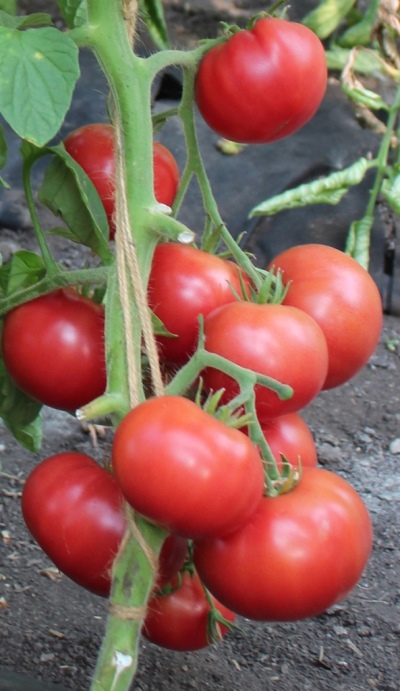
- Authors: Kandoba E.E., Kandoba A.V.
- Year of approval: 2015
- Category: hybrid
- Growth type: indeterminate
- Appointment: fresh consumption
- Ripening period: early
- Ripening time, days: 90-92
- Growing conditions: for open ground, for film greenhouses
- Marketability: high
- Transportability: Yes
The word combination "raspberry honey" is perceived delightfully. But in order to enjoy not only in thoughts, culture should be studied in advance. And only armed with complete objective information, it will be possible to achieve success.
Breeding history
Tomato Raspberry honey was included in the state register of garden crops in 2015. The developers of the variety are the breeders Kandoba A. V. and Kandoba E. E. Despite the relatively short history, the plant has a good reputation.
Description of the variety
Raspberry honey is a great hybrid tomato. It is characterized by determinant development. The variety is designed for growing in open ground and in greenhouses under plastic wrap. Medium-sized foliage develops on the bushes. It is characterized by a light green color.
The main qualities of the fruit
The berries of Raspberry Honey, when they first form from the ovary, are green in color. There will be no spots near the base. Fully ripe tomatoes acquire a raspberry color corresponding to the variety name. These are large tomatoes weighing 130-150 g. Their other features:
simple rounded configuration;
smooth skin over the entire surface;
development from intermediate type inflorescences;
articulated peduncle.
Taste characteristics
A comfortable sweet taste is typical for Raspberry Honey. The pulp is dense and sugary. The share of dry matter reaches 5%. Inside there are 5 or 6 compartments with seeds.
Ripening and fruiting
Raspberry honey is one of the earliest tomatoes. The harvest will be ready in 90-92 days. The count is traditionally taken from the first green seedlings.
Yield
The productivity of Raspberry honey is very high. It is stated that thanks to the efforts of modern breeders, it is capable of producing from 16.8 to 18 kg of berries. However, such a result will be obtained only by diligent farmers who impeccably follow the measures of caring for this crop.
The timing of planting seedlings and planting in the ground
It is necessary to sow seeds for seedlings in the first 10 days of spring. Only in regions with a harsh climate can this moment be postponed. However, in fact, it will be more correct to breed the plant in a greenhouse and get the optimal result due to this. Seedlings should develop in containers for 50-55 days. Consider soil properties and actual temperature.

Growing tomato seedlings is an extremely important process, because it largely depends on whether the gardener can harvest at all. All aspects must be taken into account, from seedbed preparation to planting in the ground.
Landing scheme
For 1 sq. m it is necessary to arrange no more than 3 or 4 plants. The density selection criteria are traditional and hardly deserve a separate analysis. The distances between the holes and the aisles are selected in the same way as for most other tomatoes.

Growing and care
The bushes will have to form in 1 or 2 stems. It should be borne in mind that Raspberry honey is extremely light-loving and thermophilic. In the middle lane, not to mention the more northern regions, it must be bred in greenhouses. The immunity of this variety is weak. Therefore, it is important to help him by carrying out preventive treatments.
And also an important problem is the insignificant thickness of the stem and branches. Because of this, even with a limited harvest, it is impossible to do without tying. During active development, the tomato needs fertilizing with potassium and phosphorus. Fertilizers are applied 4 or 5 times during the season. Water the plants in moderation, preferably in the evening.
Among the diseases, apical rot is especially dangerous. To reduce the hazard, it is necessary to reduce the amount of nitrogen in the soil. The affected bushes are sprayed with calcium nitrate. Greenhouses must be thoroughly ventilated. When grown outdoors, it is often necessary to manually remove the slugs.




A plant needs different micronutrients at each stage of growth. All fertilizers can be divided into two groups: mineral and organic. Folk remedies are often used: iodine, yeast, bird droppings, eggshells.
It is important to observe the rate and period of feeding. This also applies to folk remedies and organic fertilizers.


Growing regions
Raspberry honey bushes can reward people with a decent harvest:
in the suburbs and various localities of the Far East;
on the territory of Western Siberia;
in the middle lane;
in the Astrakhan, Volgograd regions and other Volga regions;
in the Urals, in the North Caucasus;
in the north and northwest of the European part of Russia;
in the Central Black Earth Region.
Review overview
The sweetness of this variety is beyond doubt. Very large fruits develop on the bushes. They are attractive in a wide variety of culinary uses.In general, such a plant does not create any problems. It can delight even the most discerning gardeners.

























































































